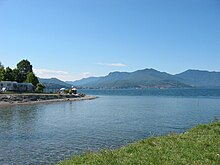Maccagno
Maccagno is a district of the municipality of Maccagno con Pino e Veddasca, formed in 2014, and is located on the east bank of Lake Maggiore in the Italian province of Varese . The place is divided into an upper district of Maccagno superiore and the district of Maccagno inferiore, located directly on the lake, which are separated by the Giona river and is located at an altitude of 210 m. ü. The local saints are Stephen ( December 26th ) and San Materno di Milano ( July 18th ).
Place name
The name of the place, which was already settled in prehistoric and Roman times, is said to come from the Latin word "Maccus", in German roughly Harlequin . This became "Macchi", with the residents with this surname making up the largest group there.
Around the year 1270, the name "Macagnio" caught on.
history
Secure records have been passed down since 926, when Maccagno Superiore became part of the fiefdom of the "Four Valleys".
According to legend, the inhabitants of Maccagno Inferiore are said to have welcomed Emperor Otto the Great during his Italian campaign against Berengar II , whereupon Otto is said to have elevated the place to a free county in thanks for services rendered and given it as a free fiefdom to Fazio and Robaconte Mandelli. It is certain that Henry IV confirmed Count Ottone Mandelli as feudal lord in 1110 and that Charles V appointed Giacomo Mandelli Count of the Holy Roman Empire in 1541 . He was given the right to hold a market, which has been held regularly since then, now in Luino, five kilometers south .
A lasting change occurred on July 18, 1622, when Ferdinand II granted Count Giacomo the right to mint coins, thus establishing the Maccagno mint. In particular, the market traded in large quantities of grain that was transported by water. However, when a law was introduced banning the export of grain, the market lost its importance in trading centers that were under the control of the Borromeans . The area's efforts to maintain its independence were ultimately in vain: in 1692, Maccagno had to renounce his autonomy and submitted to a powerful Milanese family: Giovanni Battista Mandelli, the last liege, sold the fief to Count Carlo Borromeo.
The city flourished again at the beginning of the 18th century when this family began to build businesses there that could use water power to generate energy. This is how mills and sawmills emerged, in which the abundant larch and fir wood from the surrounding mountains was processed. Some businesses that started out in the artisanal style have now developed into industrial operations. The main source of income for the residents of Maccagno is now tourism.
Five days later, on the basis of Regional Law No. 8 of January 30, 2014, the previously independent municipalities of Maccagno, Pino sulla Sponda del Lago Maggiore and Veddasca merged to form the new municipality of Maccagno con Pino e Veddasca . On December 31, 2013, the municipality had 2065 inhabitants on an area of 16 km². The municipality belonging fractions Campagnano, Caviggia, Entiglio, Garabiolo, Monte Venere, Musignano, Orascio, Pianca, Piantonazzo, Sarangio and Veddo. Neighboring communities were Agra , Cannobio (VB), Dumenza , Luino , Pino sulla Sponda del Lago Maggiore, Tronzano Lago Maggiore and Veddasca.
tourism
Maccagno has a pebble beach several hundred meters long with a well-developed tourist infrastructure near the center and a museum for modern art.
Attractions
- Parish church of Sant'Antonio abate in Garabiolo with frescoes by the painter Antonio da Tradate
- San Materno Church in Maccagno Superiore
- Church of Santi Stefano e Michele in Maccagno Inferiore
- Oratory Madonna della Punta in Maccagno Inferiore
- La Torre Imperiale
- Former Zecca (mint)
- Parisi Valle di Arte Contemporanea Museum, built by architect Maurizio Sacripanti
Sons and daughters
- Antonio da Musignano called Lombardo (* around 1445 in Musignano, fraction of Maccagno; † after 1510 in Urbino ), son of Giacomo, sculptor in Perugia
- Domenico della Bella called Macaneo (* 1466 in Maccagno; † 1530 ibid), local historian, author of the Chorographia Verbani laci and the Epitomae historicae novem ducum Sabaudorum
- Ferdinando Caronesi (born October 11, 1794 in Maccagno Superiore, † October 24, 1842 in Turin ), architect of neoclassicism (visual arts)
- Angelo Pedroni (1914–1992), Archbishop and Diplomat of the Holy See
literature
- Anna Ferrari-Bravo, Paola Colombini: Guida d'Italia. Lombardia (esclusa Milano). Milano 1987, pp. 218-222.
- Lombardia. Edited by the Touring Club Italiano. Touring Editore, Milano 1999, ISBN 88-365-1325-5 , Maccagno .
- Luca Gianazza: La Zecca di Maccagno inferiore e le sue monete. Alberti editore, Intra 2003.
Web links
- Information about Maccagno (Italian)
- Maccagno (Italian) on sibrium.org/en/Research/ (accessed November 25, 2015)
- Maccagno on de.lagomaggiore.net; Retrieved November 25, 2015
- Maccagno on the ETHorama platform
Individual evidence
- ↑ Antonio da Tradate in lariointelvese.eu
- ↑ Fresco by the painter Antonio da Tradate in varesenews.it
- ^ Parrocchia di San Materno (Italian) in lombardiabeniculturali.it
- ^ Parrocchia di Santo Stefano (Italian) in lombardiabeniculturali.it
- ↑ Oratorio Madonna della Punta (Italian) in verbanensia.org
- ^ Museum Parisi Valle in lombardiabeniculturali.it
- ^ Antonio da Musignano . In: Ulrich Thieme , Felix Becker (Hrsg.): General Lexicon of Fine Artists from Antiquity to the Present . Founded by Ulrich Thieme and Felix Becker. tape 1 : Aa – Antonio de Miraguel . Wilhelm Engelmann, Leipzig 1907, p. 590 ( Textarchiv - Internet Archive ).
- ↑ Domenico Macaneo (Italian) on ilritornodeiclassici.it (accessed December 15, 2016).
Coordinates: 46 ° 3 ' N , 8 ° 44' E



